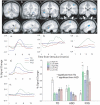Brain function and gaze fixation during facial-emotion processing in fragile X and autism
- PMID: 19360673
- PMCID: PMC2679695
- DOI: 10.1002/aur.32
Brain function and gaze fixation during facial-emotion processing in fragile X and autism
Abstract
Fragile X syndrome (FXS) is the most commonly known genetic disorder associated with autism spectrum disorder (ASD). Overlapping features in these populations include gaze aversion, communication deficits, and social withdrawal. Although the association between FXS and ASD has been well documented at the behavioral level, the underlying neural mechanisms associated with the social/emotional deficits in these groups remain unclear. We collected functional brain images and eye-gaze fixations from 9 individuals with FXS and 14 individuals with idiopathic ASD, as well as 15 typically developing (TD) individuals, while they performed a facial-emotion discrimination task. The FXS group showed a similar yet less aberrant pattern of gaze fixations compared with the ASD group. The FXS group also showed fusiform gyrus (FG) hypoactivation compared with the TD control group. Activation in FG was strongly and positively associated with average eye fixation and negatively associated with ASD characteristics in the FXS group. The FXS group displayed significantly greater activation than both the TD control and ASD groups in the left hippocampus (HIPP), left superior temporal gyrus (STG), right insula (INS), and left postcentral gyrus (PCG). These group differences in brain activation are important as they suggest unique underlying face-processing neural circuitry in FXS versus idiopathic ASD, largely supporting the hypothesis that ASD characteristics in FXS and idiopathic ASD reflect partially divergent impairments at the neural level, at least in FXS individuals without a co-morbid diagnosis of ASD.
Figures




References
-
- Adolphs R. The neurobiology of social cognition. Current Opinion in Neurobiology. 2001;11:231–239. - PubMed
-
- Bailey DB, Roberts JE, Hooper SR, Hatton DD, Mirrett PL, Schaaf JM. Research on fragile X syndrome and autism: Implications for the study of genes, environments, and developmental language disorders. In: Rice ML, Warren SF, editors. Developmental Language Disorders: From Phenotypes to Etiologies. Lawrence Erlbaum Associates, Inc; Manwah, NJ: 2004. pp. 121–150.
-
- Belmonte MK, Bourgeron T. Fragile X syndrome and autism at the intersection of genetic and neural networks. Nature Neuroscience. 2006;9(10):1221–1225. - PubMed
-
- Bird G, Catmur C, Silani G, Frith C, Frith U. Attention does not modulate neural responses to social stimuli in autism spectrum disorders. NeuroImage. 2006;31:1614–1624. - PubMed
Publication types
MeSH terms
Grants and funding
LinkOut - more resources
Full Text Sources
Medical

